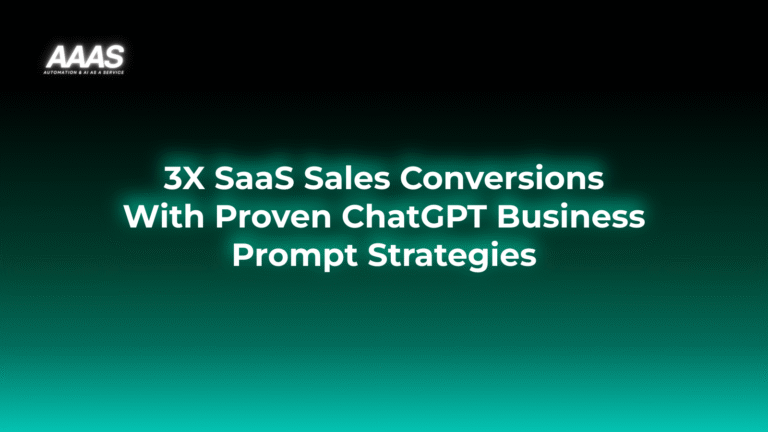Best Practices: ChatGPT Business Prompts for SaaS Sales Enablement & Increased Customer Conversions
Market Problem
SaaS companies face intense competition and rising customer expectations for instant, personalized sales engagement. Traditional sales enablement tactics suffer from:
- Delayed response times to inbound leads
- Inefficient manual qualification processes
- Fragmented knowledge and unscalable touchpoints
- Lack of consistent messaging
These pain points result in lost leads, longer sales cycles, and missed revenue opportunities.
Solution & Benefits: Leveraging ChatGPT Business Prompts

Integrating ChatGPT with automated business prompts revolutionizes how SaaS companies engage and convert prospects. Key benefits include:
- Instant Qualification: 24/7 AI responds and qualifies leads automatically.
- Personalized Engagement: Context-aware prompts tailor conversations per user segment.
- Consistency: Ensures sales messaging always aligns with brand guidelines.
- Efficiency: Sales teams focus on closing, not repetitive Q&A.
- Scalability: AI handles unlimited concurrent interactions, eliminating bottlenecks.
- Data-driven Insights: Prompts can route, categorize, and log valuable prospect data for further analysis.
Real Use Cases
1. Lead Qualification Bots
Prompt-driven ChatGPT bots collect key information (company size, use case, budget) and qualify prospects instantly—speeding up handoff to sales reps.
2. Tailored Demo Scheduling
ChatGPT can converse with prospects, ask context-driven questions, and use business prompts to book personalized demos—removing friction and human error.
3. Objection Handling
Sales teams use prompt templates to automate rebuttals for common concerns (pricing, features), ensuring prospects receive consistent, accurate, persuasive responses.
4. Knowledge Base Navigation
ChatGPT guides prospects through FAQs and feature documentation in real time, improving self-serve capabilities and reducing pre-sales support load.
Technical Details
- Prompt Engineering: Design structured business prompts for lead capture, segmentation, and product navigation.
- API Integrations: Connect ChatGPT to your CRM (e.g., Salesforce, HubSpot), email, and scheduling tools for seamless data flow.
- Security & Compliance: Ensure prompts do not collect sensitive data unless GDPR/CCPA compliant.
- Fallback Logic: Route complex queries to human reps based on sentiment and intent analysis.
- Analytics: Track prompt engagement, conversion rates, and sales-cycle velocity via dashboards and reporting tools.
Comparison with Alternatives
| Solution | Automation | Personalization | Scale | Sales Impact |
|---|---|---|---|---|
| ChatGPT with Business Prompts | Full (24/7, complex queries) | High | Unlimited | Significant—qualified leads, faster cycle |
| Traditional Chatbots | Limited (rule-based) | Low-Moderate | Variable | Moderate—prone to drop-offs |
| Manual Outreach | None | High (personal, but slow) | Low | Variable—depends on team size |
Pricing Table: ChatGPT SaaS Sales Enablement Solutions
| Plan | Monthly Cost | Features |
|---|---|---|
| Starter | $49 | Basic prompts, FAQ automation, up to 1,000 conversations |
| Growth | $199 | Custom prompt flows, CRM integration, analytics, 10,000 conversations |
| Enterprise | Custom | Advanced AI features, unlimited use, SLA, dedicated support |
Most providers offer a free trial or demo. See OpenAI pricing.
ROI-Focused Practical Examples
- 60% Faster Response: A SaaS startup deployed ChatGPT-based lead qualification and saw sales respond times drop from 8 hours to under 2 min.
- 30% Higher Demo Conversions: Real estate SaaS saw demos increase after tailoring prompts to industry-specific objections.
- Resource Saving: A growth-stage SaaS saved $20,000/yr in SDR costs by automating common pre-sales questions with ChatGPT prompts.
Setup Steps
- Choose your ChatGPT provider and platform integration method (e.g., web widget, API, CRM plugin).
- Map out your sales funnel and identify high-friction touchpoints for automation.
- Create prompt libraries for each customer segment and sales stage.
- Integrate ChatGPT with your CRM for data capture and workflow automation (see integration guides).
- Test prompt flows, A/B test conversation scripts, and enable fallback for complex queries.
- Monitor analytics, gather feedback, and iterate prompt design monthly.
Pros and Cons List
Pros
- Significantly increases lead response speed and qualification quality
- Delivers consistent, brand-aligned messaging at scale
- Reduces load on human reps and lowers operational costs
- Data-rich conversations for continuous sales process improvement
Cons
- Requires prompt engineering and periodic review to maintain relevance
- Risk of poor user experience if fallback to humans is not well-designed
- May not fully replace complex, relationship-driven sales interactions
- Ongoing cost and API usage fees can scale with volume
Expert Tips for SaaS Teams
- Continuously audit and improve your prompt templates based on real customer conversations.
- Segment prompts by ICP (Ideal Customer Profile) to tailor engagement at every funnel stage.
- Always provide an easy path to a human agent for high-value or complex prospects.
- Integrate ChatGPT analytics with your main sales dashboards for a holistic conversion view.
- Test prompt flows quarterly against real competitor sites to benchmark performance (Prompt benchmarking reference).
FAQ
- Can ChatGPT business prompts replace my inside sales team?
- No. While ChatGPT streamlines repetitive interactions and qualification, human reps are vital for complex deals and relationship building.
- Is ChatGPT compliant with data privacy regulations?
- Yes, if implemented with proper controls and prompts avoid personal data collection outside compliance boundaries (see GDPR guidelines).
- Can I use ChatGPT prompts on mobile apps?
- Yes, via API or SDK integrations compatible with iOS, Android, and web platforms.
- How often should I review my prompt library?
- Monthly reviews recommended; real-world data quickly reveals gaps or outdated information.
- What metrics should I track?
- Key metrics: lead qualification rate, response time, demo conversions, drop-off rate, and sales velocity.
References & Citations








